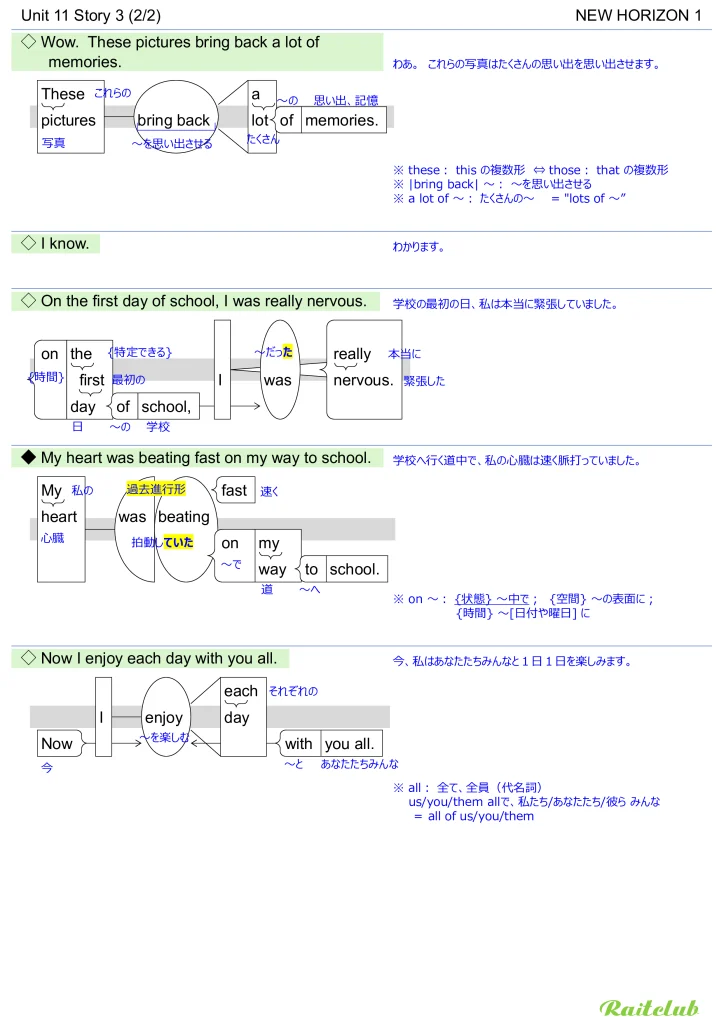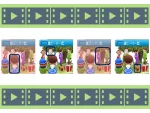中学1年生教科書 New Horizon 1 (ニューホライズン 1年) Unit 11: This Year’s Memories の重要文法と、本文・和訳・英文見える化チャートです。
英文見える化チャートは、英語の「意味理解」を視覚的にサポートするツールです。習得を促進する音声付きです。音読活動などで活用することで英語を身に着けるのを支援します。
ポイント解説付きなので、定期テスト対策として、単語の意味・用法や、文法・文構造の確認にも使えます。
なおこのページでは英語のみの音声も聞けます。リスニングやシャドウイングなどでお使いいただけます。
重要文法
【~でした。】 be動詞の過去形(was, were)
➡ He was happy.
問:Was he happy? 答:Yes, he was. [No, he was not.]
否:He was not happy.
【□があります。】 There is [are]
➡ There is a park around here.
問:Is there a park around here? 答:Yes, there is. [No, there is not.]
否:There is not a park around here.
【・・・していました。】 過去進行形
➡ I was watching TV.
問:Were you watching TV? 答:Yes, I was. [No, I was not.]
否:I was not watching TV.
本文・和訳・チャート
音声リスト
※ バックグラウンド再生もできます
以下の各パート内の音声は速度調整や個別にループ再生もできます
Unit 11 Story 1
◇ I joined the soccer team in April.
私は4月にサッカーチームに加わりました。
※ the: {文脈・状況から皆が特定できるものを指す時} (その)~
◆ At first, I was really tired after practice, but I tried hard.
最初は私は練習後、本当に疲れましたが、私は一生懸命に試みました。
◆ was: is, am の過去形
※ at first: はじめのころ
※ tried: tryの過去形 y を i に変えて “ed” ← 子音字+ y で終わる動詞
◇ In January, we had a rookies’ game.
1月に私たちは新人戦がありました。
※ a: {初めて言及する単体を指す時} (ある、ひとつの)
※ rookies’: rookies(rookyの複数形)の所有の形
複数形には ‘s でなく ‘ のみをつけ発音は変えない(複数形と同じ発音)
◆ It was my first game against another school.
それは私の初めての他校に対抗する試合でした。
◆ Wow. Were you a starter?
わあ。 あなたはスタメンでしたか。
◆ were: are の過去形
◆ No, I wasn’t.
いいえ、そうではありませんでした。
◆ wasn’t: was not の短縮形
参考)weren’t: were not の短縮形
◇ I played from the second half.
私は後半からプレーしました。
◇ I see.
なるほど。
◇ How was the game?
試合はどうでしたか。
◇ We did our best, but we lost 2 to 1.
私たちはベストを尽くしましたが、2対1で負けました。
※ did: ~を行うを意味する do (動詞) の過去形
※ do one’s best: ~のベスト(最善)を尽くす
one’s→my, your, his, her, its, our, theirなど
※ lost: lose の過去形
※ X to Y: {2つの数値などを比較して} X 対 Y
◇ We were all sad, but maybe we can win the next game!
私たちみんなは悲しかったですが、もしかすると次の試合に勝つことができます。
※ all: 全て、全員(代名詞)
we all: 私たちみんなは you all, they allも同様
= all of us all of you, all of them
allはbe動詞の後ろに置くこともできる
※ maybe: 確信はないがその可能性があると言う時に使う
◇ I hope so!
私はそのように望みます。
※ so: {直前の考えなどに再度言及し} そのように
音声(英語/習得用)
| ♪ 英語の音声: | |
| 1回再生 | |
|---|---|
| ループ再生 | |
| ♪ 習得用の音声(英⇒日を区切りごと): | |
| 1回再生 | |
|---|---|
| ループ再生 | |
英文見える化チャート 1/2
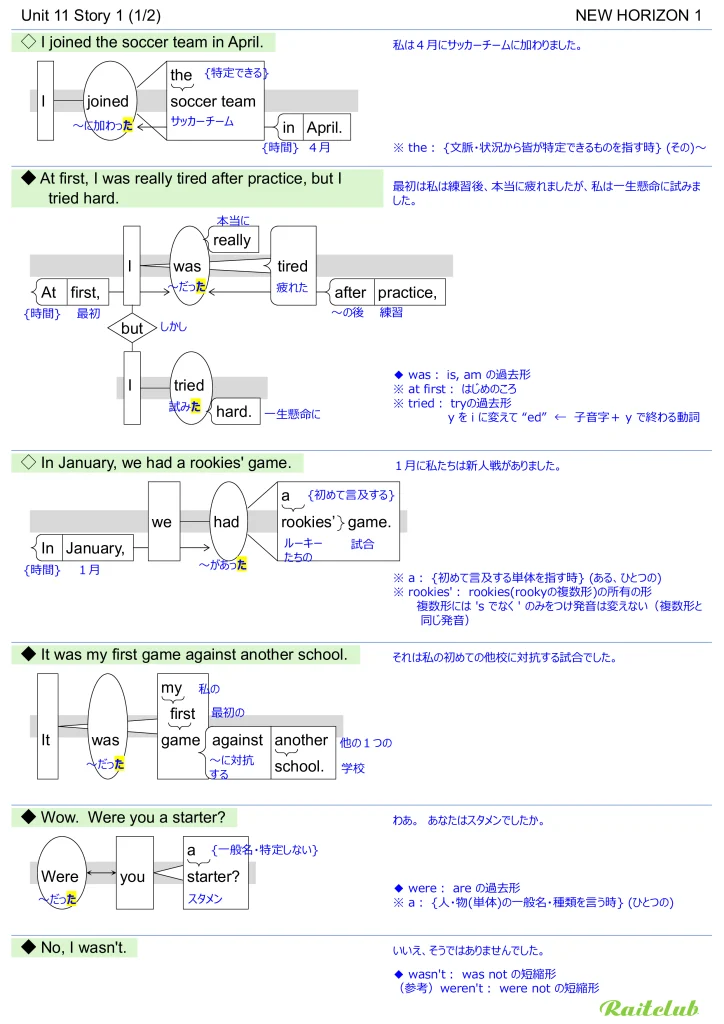
英文見える化チャート 2/2
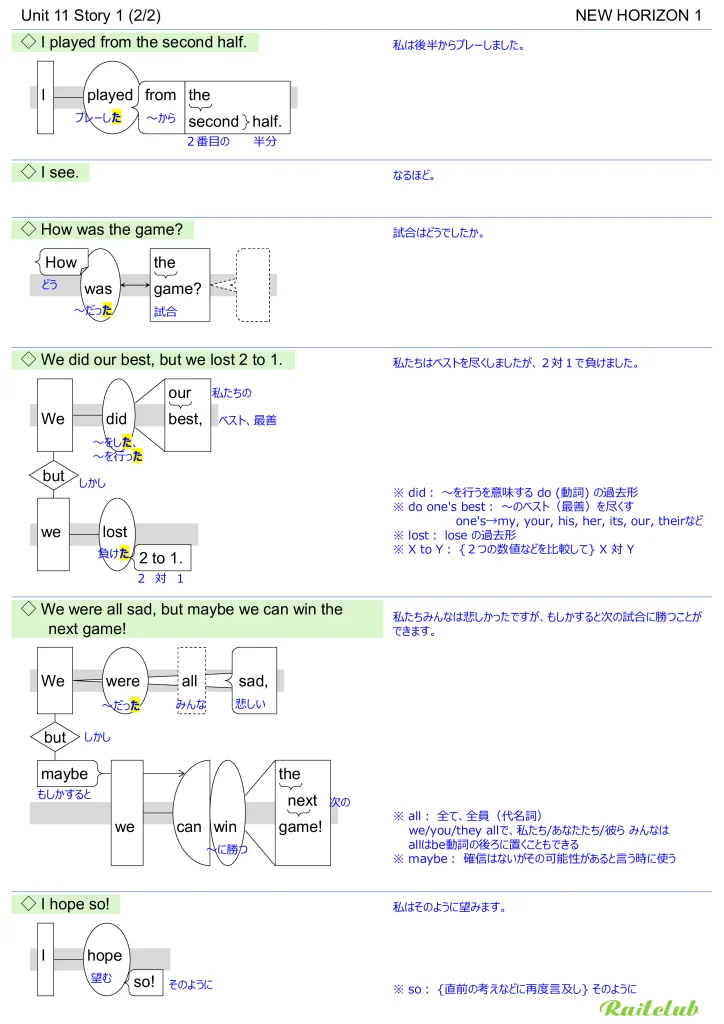
Unit 11 Story 2
◇ In July, we went to Lake Sakura on our school camping trip.
7月に私たちは学校のキャンプ旅行でさくら湖へ行きました。
※ on: {目的} ~で 例:on vacation
◇ Lake Sakura is at the foot of Mt. Asahi.
さくら湖はあさひ山の足の所(ふもと)です。
※ the ~: {人の体の一部を指し} ~ *the は特に訳さない
※ Mt. ~: {山の名前の一部} ~山 Mountの短縮形
◆ Is there a campground near the lake?
その湖の近くにキャンプ場はありますか。
◆ 実物を特定せずに物(人間含む)が存在することを話題に出すには、”There is [are] ~”を使う。
主語は”~”で、単数なら is、複数なら are を動詞にする。
◆ 質問するには”Is [Are] there ~?”とし、否定するには動詞の後に not を置く
◆ Yes, there is.
はい、あります。
◆ There are showers and outdoor kitchens, too.
シャワーと屋外キッチンもあります。
◇ So we set up tents and stayed for two nights.
なので私たちはテントを設営し、2夜滞在しました。
※ |set up| ~: ~[装置など]を使える状態に準備する
※ set: setの過去形
◇ Sounds like fun.
(それは)おもしろいことのように聞こえます。 → おもしろそうですね。
※ “sound + 形容詞など”で、「~に聞こえる」と聴覚的な判断を表す。
「主語=形容詞など」となるのはbe動詞文に似ているが、疑問文や否定文の作り方は一般動詞の場合と同じ
※ like ~: ~のような
◇ Was it beautiful there?
そこでは(状況は)きれいでしたか。
※ it: その場の状況、出来事をさす; 天候、時刻を言う時に主語にする; {既に言及されたものをさして} それ
◆ Yes, but there was some trash near the lake, so we picked it up.
はい、しかし湖の近くにいくらかゴミがあったので、私たちはそれを拾いました。
※ |pick up| ~: ~を集める、~を持ち上げる
= pick ~ up → ~が代名詞の場合はこの形のみ
◇ Good job.
よくやりました。
※ good job: 人が何かをうまく行った時に言う表現
音声(英語/習得用)
| ♪ 英語の音声: | |
| 1回再生 | |
|---|---|
| ループ再生 | |
| ♪ 習得用の音声(英⇒日を区切りごと): | |
| 1回再生 | |
|---|---|
| ループ再生 | |
英文見える化チャート 1/2
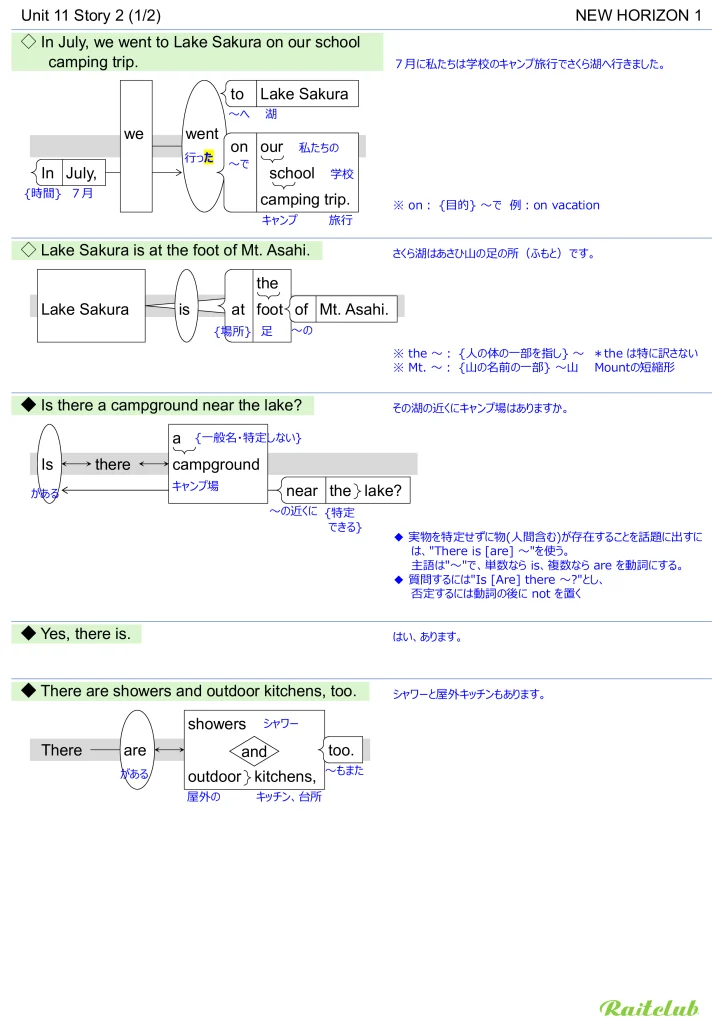
英文見える化チャート 2/2
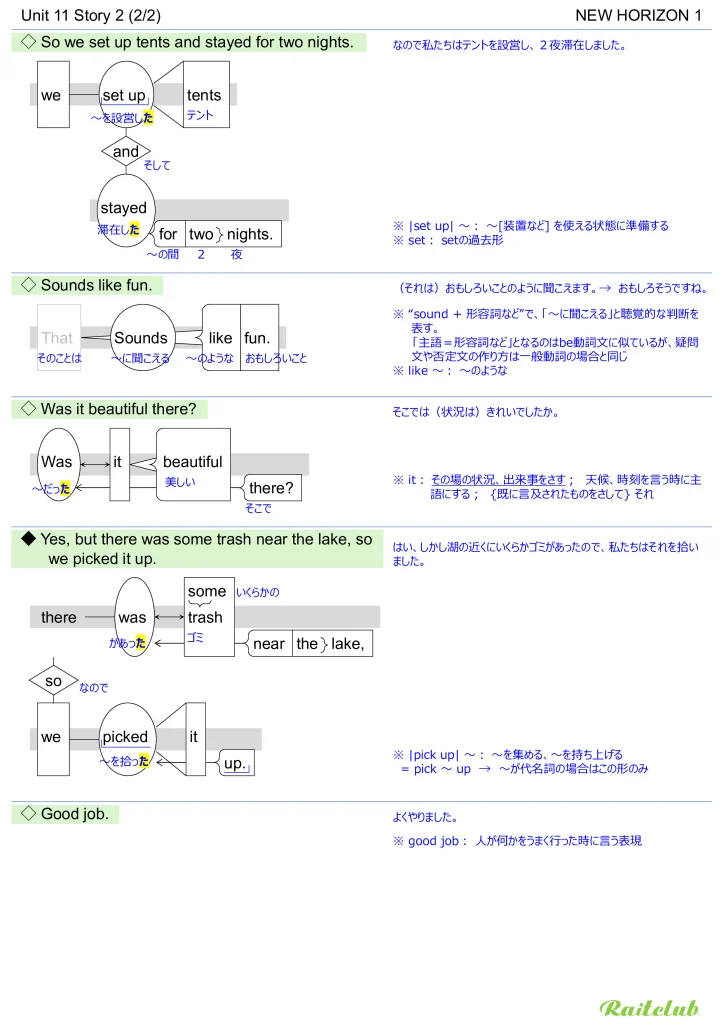
Unit 11 Story 3
◇ Hey, Kaito.
やあ、かいと。
◇ I didn’t see you during lunch break.
私は昼休みの間にあなたを見ませんでした。
◆ What were you doing?
あなたは何をしていましたか。
◆ “be動詞の過去形 + …ing” の形で、「…していた」の意味になる {過去進行形}
◆ I was playing soccer outside.
私は外でサッカーをプレーしていました。
◆ Were you looking for me?
あなたは私を探していましたか。
※ |look for| ~: ~を探す
◇ Yes. I wanted to show this to you.
はい。 私はあなたにこれを見せたかったです。
◇ I made a photo album for this year.
私は今年の写真アルバムを作りました。
※ for ~: {(関心/感情の)対象} ~にとって、~に関して
◇ Wow. These pictures bring back a lot of memories.
わあ。 これらの写真はたくさんの思い出を思い出させます。
※ these: this の複数形 ⇔ those: that の複数形
※ |bring back| ~: ~を思い出させる
※ a lot of ~: たくさんの~ = “lots of ~”
◇ I know.
わかります。
◇ On the first day of school, I was really nervous.
学校の最初の日、私は本当に緊張していました。
◆ My heart was beating fast on my way to school.
学校へ行く道中で、私の心臓は速く脈打っていました。
※ on ~: {状態} ~中で; {空間} ~の表面に; {時間} ~[日付や曜日] に
◇ Now I enjoy each day with you all.
今、私はあなたたちみんなと1日1日を楽しみます。
※ all: 全て、全員(代名詞)
you all: あなたたちみんな us all, them allも同様
= all of you all of us, all of them
音声(英語/習得用)
| ♪ 英語の音声: | |
| 1回再生 | |
|---|---|
| ループ再生 | |
| ♪ 習得用の音声(英⇒日を区切りごと): | |
| 1回再生 | |
|---|---|
| ループ再生 | |
英文見える化チャート 1/2
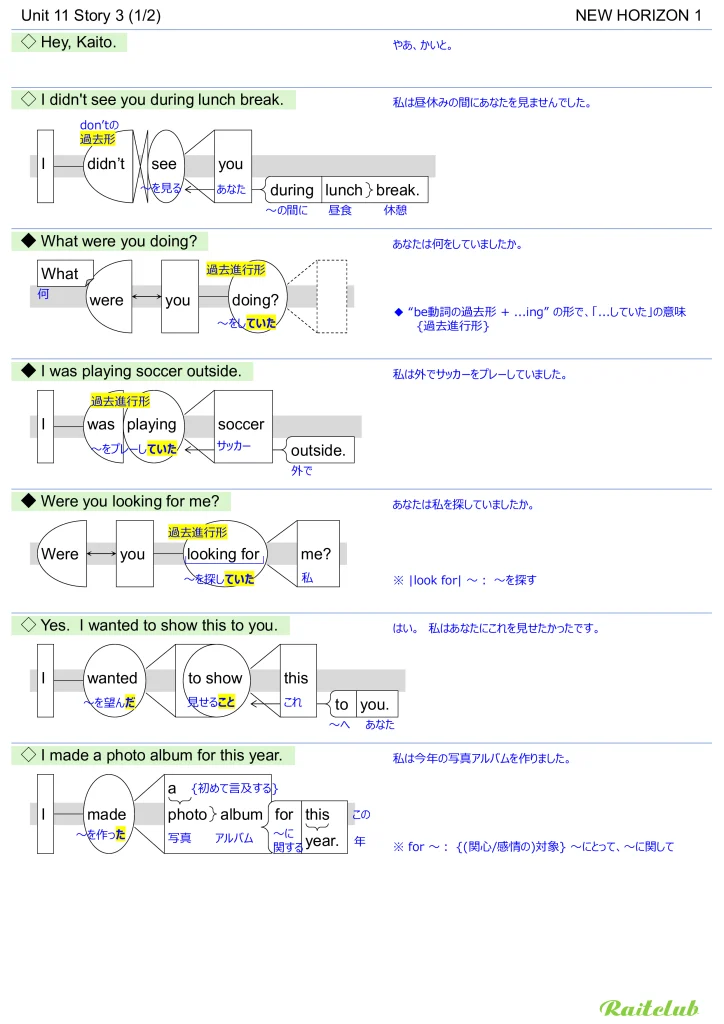
英文見える化チャート 2/2
